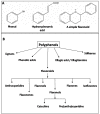Gut Fermentation of Dietary Fibres: Physico-Chemistry of Plant Cell Walls and Implications for Health
- PMID: 29053599
- PMCID: PMC5666883
- DOI: 10.3390/ijms18102203
Gut Fermentation of Dietary Fibres: Physico-Chemistry of Plant Cell Walls and Implications for Health
Abstract
The majority of dietary fibre (DF) originates from plant cell walls. Chemically, DF mostly comprise carbohydrate polymers, which resist hydrolysis by digestive enzymes in the mammalian small intestine, but can be fermented by large intestinal bacteria. One of the main benefits of DF relate to its fermentability, which affects microbial diversity and function within the gastro-intestinal tract (GIT), as well as the by-products of the fermentation process. Much work examining DF tends to focus on various purified ingredients, which have been extracted from plants. Increasingly, the validity of this is being questioned in terms of human nutrition, as there is evidence to suggest that it is the actual complexity of DF which affects the complexity of the GIT microbiota. Here, we review the literature comparing results of fermentation of purified DF substrates, with whole plant foods. There are strong indications that the more complex and varied the diet (and its ingredients), the more complex and varied the GIT microbiota is likely to be. Therefore, it is proposed that as the DF fermentability resulting from this complex microbial population has such profound effects on human health in relation to diet, it would be appropriate to include DF fermentability in its characterization-a functional approach of immediate relevance to nutrition.
Keywords: cereals; fruit; large intestinal fermentation; microbiota; plant cell walls; polyphenols; short-chain fatty acids; vegetables.
Conflict of interest statement
The authors declare no conflict of interest.
Figures



References
-
- World Health Organisation . Diet, Nutrition and the Prevention of Chronic Diseases. Report of a Joint WHO FAO Expert Consultation. Volume 916. World Health Organisation; Geneva, Switzerland: 2003. pp. 1–149. (World Health Organisation Technical Report Series). - PubMed
-
- World Cancer Research Fund and American Institute for Cancer Research . Food, Nutrition, and Physical Activity: A Global Perspective. Research, A.I.C.R; Washington, DC, USA: 2009. Policy and Action for Cancer Prevention.
-
- Astorg P., Boutron-Ruoult M.C., Andrieux C., Blachier F., Blottiere H., Bonithon-Kopp C., Boutron-Ruault M.C., Cassand P., Chaumontet C., Cherbut C., et al. Dietary fibers and colorectal cancer. Experimental studies, epidemiology, mechanisms. Gastroenterol. Clin. Biol. 2002;26:893–912. - PubMed
-
- Bazzano L.A., He J., Ogden L.G., Loria C.M., Vupputuri S., Myers L., Whelton P.K. Fruit and vegetable intake and risk of cardiovascular disease in US adults: The first National Health and Nutrition Examination Survey Epidemiologic Follow-up Study. Am. J. Clin. Nutr. 2002;76:93–99. - PubMed
-
- Chuang S.-C., Norat T., Murphy N., Olsen A., Tjønneland A., Overvad K., Boutron-Ruault M.C., Perquier F., Dartois L., Kaaks R., et al. Fiber intake and total and cause-specific mortality in the European Prospective Investigation into Cancer and Nutrition cohort. Am. J. Clin. Nutr. 2012;96:164–174. doi: 10.3945/ajcn.111.028415. - DOI - PubMed
Publication types
MeSH terms
Substances
LinkOut - more resources
Full Text Sources
Other Literature Sources
Medical
Miscellaneous

